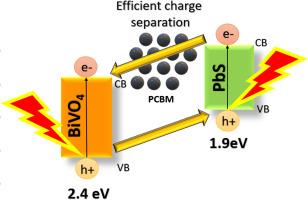Phenyl-C61-butyric acid methyl ester (PCBM) nanoparticle mediated boasting of photoelectrochemical and photocatalytic properties of bismuth vanadate/lead sulphide (BiVO4/PbS) composite thin-film
e-Prime - Advances in Electrical Engineering, Electronics and Energy
Pub Date : 2024-11-08
DOI:10.1016/j.prime.2024.100837
引用次数: 0
Abstract
This work delineates the fabrication and characterization of BiVO4/PbS and BiVO4/PCBM/PbS-based composite heterostructure for visible-light-driven applications, such as pollution remediation, photoelectrochemistry (PEC), and applied bias to photoelectrochemical hydrogen generation efficiency (ABPE). The heterostructured composite was synthesized by a combination of Spin coating (for bismuth vanadate - BiVO4 thin film fabrication and PCBM deposition), and Successive Ionic Layer Absorption and Reaction -SILAR (for lead sulphide - PbS deposition) method and characterized using UV–visible Spectroscopy, time-resolved photoluminescence spectroscopy (TRPL), field emission scanning electron microscope (FESEM), X-ray diffraction (XRD), and photoelectrochemistry (PEC) analysis (PEC). The key benefit of incorporation of PCBM nanoparticles in BiVO4/PCBM/PbS was realized through 1) ∼ 70 % improvement in the photocurrent density during electrochemistry analysis, 2) ∼ 2.3 times enhancement in ABPE, and 3) ∼ 43 % enhancements in ‘rate constant’ towards photocatalytic (methylene blue) degradation compared to BiVO4/PbS. The work shows the benefits of the PCBM-conductive carbon-based electron transport layer as a bridge between two inorganic semiconductors (BiVO4 and PbS) towards enhancing fast electron separation and transport at the interface during visible light irradiation.

以苯基-C61-丁酸甲酯(PCBM)纳米粒子为介导,提高钒酸铋/硫化铅(BiVO4/PbS)复合薄膜的光电化学和光催化性能
这项工作描述了基于 BiVO4/PbS 和 BiVO4/PCBM/PbS 的复合异质结构的制备和表征,这些异质结构可用于可见光驱动的应用,如污染修复、光电化学(PEC)和光电化学制氢效率(ABPE)应用偏压。异质结构复合材料是通过旋涂法(用于钒酸铋 - BiVO4 薄膜制造和 PCBM 沉积)和连续离子层吸收和反应 -SILAR 法(用于硫化铅 - PbS 沉积)合成的,并使用紫外可见光谱对其进行了表征、时间分辨光致发光光谱法 (TRPL)、场发射扫描电子显微镜 (FESEM)、X 射线衍射 (XRD) 和光电化学分析 (PEC)。与 BiVO4/PbS 相比,在 BiVO4/PCBM/PbS 中加入 PCBM 纳米粒子的主要优势体现在:1)电化学分析中的光电流密度提高了 70%;2)ABPE 提高了 2.3 倍;3)光催化(亚甲基蓝)降解的 "速率常数 "提高了 43%。这项研究表明,PCBM 导电碳基电子传输层作为两种无机半导体(BiVO4 和 PbS)之间的桥梁,可在可见光照射期间增强界面上的快速电子分离和传输。
本文章由计算机程序翻译,如有差异,请以英文原文为准。
求助全文
约1分钟内获得全文
求助全文
来源期刊
CiteScore
2.10
自引率
0.00%
发文量
0

 求助内容:
求助内容: 应助结果提醒方式:
应助结果提醒方式:


